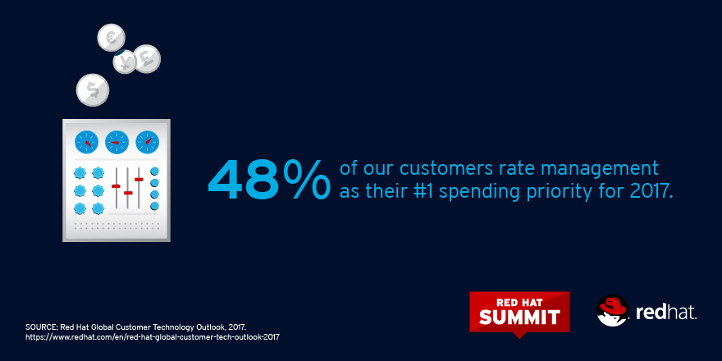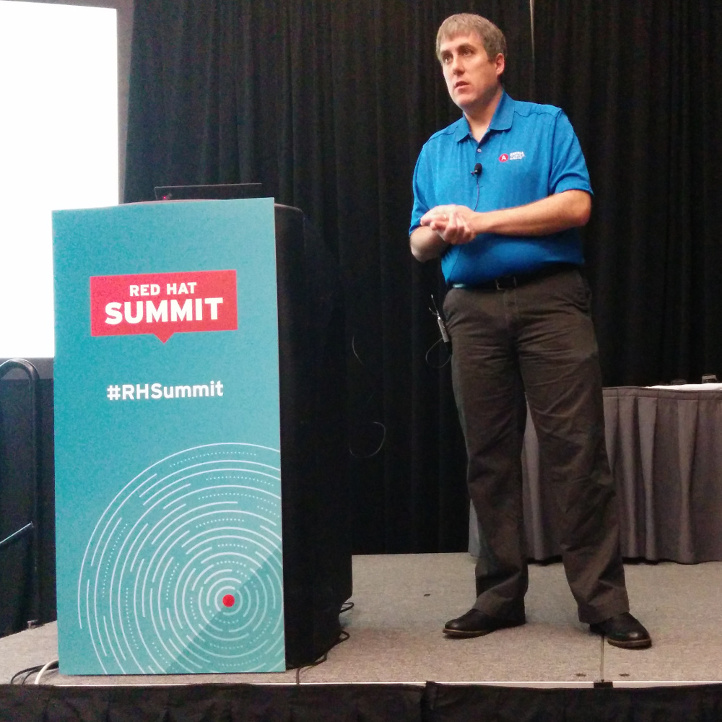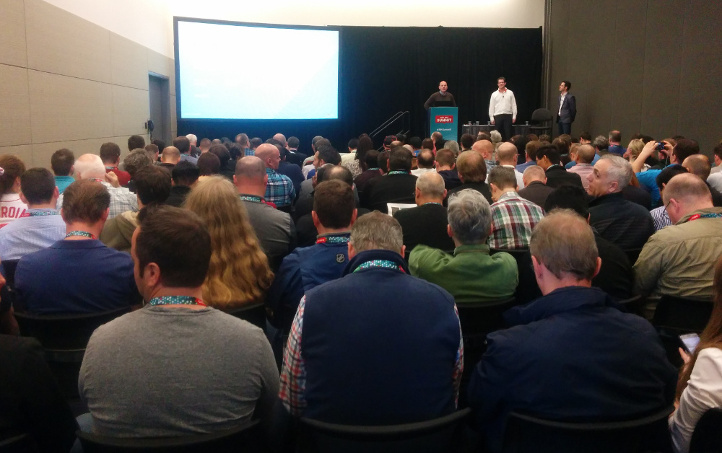Your customers’ increasing demand for services―and the growing complexity of the systems you need to provide them―can mean doing things differently.
Paul Cormier, Red Hat’s executive vice president of Products and Technology, recognized this in his general session keynote:
“As the infrastructure transforms to this hybrid model, with application development taking advantage of those changes, traditional management technologies become obsolete.”

So if traditional management isn’t as useful as it once was, what will take its place? This is no small question, as management still ranks in the top three spending priorities for Red Hat® customers in 2017.
More modern processes and practices combine automation, self-service, unified views, monitoring, and policy to create more efficient, streamlined management that can help us handle the complexity.

Bill Nottingham from Ansible by Red Hat
AUTOMATION WITH ANSIBLE
Automation enables you to solve problems once, then replicate that solution. Ansible by Red Hat is a simple automation language that describes IT applications, environments, and processes.
Bill Nottingham, senior principal product manager for Ansible, returned to Summit to give this year’s update about the latest release: Ansible Tower 3.1, launched in March 2017. Its most recent minor update (3.1.3) came out the first day of Summit. Now that’s fresh.
Nottingham described Ansible more clearly: “Ansible lets us automate the drudgery so we get our lives back to do more strategic things.” Because the language Ansible uses is simple, everyone in your organization can be involved and informed. The more you can automate, the more you can avoid manual mistakes.
Ansible is:
- Simple. It’s human-readable and doesn’t require coding skills. Tasks are executed in order and can help every team get productive quickly.
- Powerful. Ansible can help with app deployment, configuration management, orchestration, network automation, and life-cycle orchestration.
- Agentless. This type of architecture means no agents to exploit or update. Teams can get an immediate start and can keep things more secure and efficient.
ABOUT ANSIBLE TOWER
Ansible Tower is the enterprise framework for managing and helping to secure your Ansible playbooks. Playbooks are collections of Ansible tasks (modules) that make them repeatable, understandable, and ready for automation.
“Tower is built on top of Ansible,” said Nottingham. “You can use it to automate anything across your enterprise―infrastructure, networks, containers, cloud, and services.”
Tower lets teams automate by giving them more:
- Control, so they can schedule and centralize jobs.
- Knowledge, for greater visibility and compliance.
- Delegation, which allows role-based access and self-service.
“If you’ve got machines, we automate over the same protocols you use to manage them,” Nottingham said. “We want to make sure you can get started quickly and get automating.”
Nottingham detailed and demoed several Ansible Tower 3.1 enhancements.
New workflows
New workflows let you chain together any set of Ansible playbooks into a more flexible workflow. By working with jobs you’ve already defined in Tower, you can configure these workflows in different ways without having to change the playbooks.
New enterprise logging integrations
Ansible Tower can now integrate automation with system analysis like Splunk, Elastic, SumoLogic, Loggly, and even custom solutions. This helps you make more intelligent decisions about your infrastructure, based on what’s happening.
New Tower clusters
“People want to be able to have more people run more automation more often,” Nottingham said. To answer this request, Ansible Tower 3.1 lets you add more nodes to a Tower cluster, which increases capacity and improves redundancy.
ANSIBLE ROADMAP
Nottingham closed his session by looking briefly at what’s ahead for Ansible. The goal: to bring automation to your whole enterprise. This could include:
- Smart inventory based on Ansible-gathered facts.
- Greater integration with the tools, services, and processes you have today like those from Red Hat CloudForms, VMware vRealize, ServiceNow, or Splunk.
- Coordinated self-healing capabilities with Ansible Tower and Red Hat Insights.
- Additional clustering features for multiple deployment or multiple cluster scenarios.
AUTOMATION BEGETS SELF-SERVICE (WITH ANSIBLE AND CLOUDFORMS)
Automation is one of the key pieces that makes other modern management tasks possible. For example, organizations need automation to implement self-service. As presenter Gerardus Jansen, product owner for CloudForms, said, “The concept is simple and some implementations are quite simple.” But what about when things are more complex?

Standing-room only in the Ansible and CloudForms session
The benefits of self-service include things that everyone from your CEO to your IT ops teams can appreciate, such as:
- Delivering services more quickly.
- Standardizing offerings to improve compliance.
- Reducing manual behavior for better efficiency.
Despite the benefits, there are often challenges because of existing processes, practices, and expectations. Jansen described several of these roadblocks, the problems that result from them, the ways they can be avoided or remediated, and the Red Hat solutions that can make it possible.
| CHALLENGE | RESULTS | FIX | PRODUCT |
|
"Fire-it-and-forget-it"
(Creating and deploying things and then nevertouching them again)
|
|
|
Red Hat CloudForms |
|
Compliance rules and regulations that keep users from doing what they need (or really, really want) (What they really want is root.) |
|
|
Red Hat CloudForms |
| Multitier applications |
|
|
Ansible by Red Hat |
Jansen also noted that using Red Hat CloudForms and Ansible together just got easier now that Ansible is included with CloudForms 4.5.
ANSIBLE AND CLOUDFORMS AT ING BANK
William Deur, an IT specialist at ING Bank, joined Jansen to discuss how the global financial institution used CloudForms and Ansible to help with organizational change, better orchestrate virtual machine deployment, and create API-based components that encouraged collaboration.
ING now uses self-service with their custom portal, and, as Deur noted, they can do more. A lot more.
MANAGEMENT TOOLS AND CONTAINERS
In a session about managing containers at scale, Loic Avenel and members of the OpenShift team discussed the different management needs of a container-based Infrastructure-as-a-Service (IaaS) environment, including:
- Automation, for handling things at scale.
- Centralized hybrid views, including user interface, dashboard, and underlying infrastructure perspectives.
- Inventory views you can drill down, use for reporting or chargeback, or scan for security (OpenSCAP).
- Monitoring to stay on top of how projects are performing or progressing.
- Centralized policy that helps you know when something is wrong.
Avenel and his team spent the rest of the session showing how to do these things through the CloudForms dashboard―as well as some beta features that customers might see in upcoming releases, like dynamic metrics, managing and provisioning using CloudForms and Ansible, “podified” CloudForms, and other integrations (Cockpit, ELK).
Avenel noted that a lot of the innovation in Red Hat CloudForms comes from the close working relationship between CloudForms and OpenShift ops teams. The OpenShift teams operate in an automated way, and Avenel and his team look at these practices to see how they can make life easier for customers.
COX AUTOMOTIVE MANAGES EVERYTHING
And if we’re talking about Red Hat Management customers, Cox Automotive (Autotrader) automates, greater secures, and manages their big data infrastructure with a combination of Ansible, Ansible Tower, Red Hat Insights, Red Hat Satellite, and CloudForms―all on top of a Red Hat infrastructure foundation.
William Nix (from Red Hat) and Cox’s senior Linux® engineer Abdi Hersi spoke at length about the modernization and optimization efforts underway at Cox. “As our infrastructure got more sophisticated, and our process got more agile, automation became inevitable,” Hersi said.
Before automation, it took Cox a long time to provision anything―weeks or months instead of days. Hersi demonstrated their provisioning process on stage, from logging in to Satellite’s dashboard to defining global parameters to validating the new server.
“In 5 minutes, we started with Satellite―powered by Ansible―and we finished with a complete system we can add to the cluster at any time,” Hersi said. “We can do this as many times as we like.”
In the real world, it might not take 5 minutes, but it doesn’t take as long as it used to for Cox. “We can now deploy and push code to our big data infrastructure in less than 20 minutes,” Hersi said.
BRINGING IT ALL TOGETHER
As organizations move toward hybrid, cloud-native environments, there are even more opportunities for management improvement―and integration. Combining Ansible and CloudForms can give customers automation and control over service delivery.
Add Red Hat Satellite for provisioning and Red Hat Insights for preventative analytics, and your organization can create consistency, detect risks, and automatically find and fix problems before they happen.
Complexity can be controlled―as long as you’re willing to expand what you can automate, monitor, and analyze.
Are you in Boston for the last day of Summit? There are still more Ansible sessions on day 3.
And if you couldn’t make it to this year’s Summit, our blog posts can catch you up on what happened on day 2 around infrastructure, containers, and cloud.
Über den Autor
Red Hat is the world’s leading provider of enterprise open source software solutions, using a community-powered approach to deliver reliable and high-performing Linux, hybrid cloud, container, and Kubernetes technologies.
Red Hat helps customers integrate new and existing IT applications, develop cloud-native applications, standardize on our industry-leading operating system, and automate, secure, and manage complex environments. Award-winning support, training, and consulting services make Red Hat a trusted adviser to the Fortune 500. As a strategic partner to cloud providers, system integrators, application vendors, customers, and open source communities, Red Hat can help organizations prepare for the digital future.
Nach Thema durchsuchen
Automatisierung
Das Neueste zum Thema IT-Automatisierung für Technologien, Teams und Umgebungen
Künstliche Intelligenz
Erfahren Sie das Neueste von den Plattformen, die es Kunden ermöglichen, KI-Workloads beliebig auszuführen
Open Hybrid Cloud
Erfahren Sie, wie wir eine flexiblere Zukunft mit Hybrid Clouds schaffen.
Sicherheit
Erfahren Sie, wie wir Risiken in verschiedenen Umgebungen und Technologien reduzieren
Edge Computing
Erfahren Sie das Neueste von den Plattformen, die die Operations am Edge vereinfachen
Infrastruktur
Erfahren Sie das Neueste von der weltweit führenden Linux-Plattform für Unternehmen
Anwendungen
Entdecken Sie unsere Lösungen für komplexe Herausforderungen bei Anwendungen
Original Shows
Interessantes von den Experten, die die Technologien in Unternehmen mitgestalten
Produkte
- Red Hat Enterprise Linux
- Red Hat OpenShift
- Red Hat Ansible Automation Platform
- Cloud-Services
- Alle Produkte anzeigen
Tools
- Training & Zertifizierung
- Eigenes Konto
- Kundensupport
- Für Entwickler
- Partner finden
- Red Hat Ecosystem Catalog
- Mehrwert von Red Hat berechnen
- Dokumentation
Testen, kaufen und verkaufen
Kommunizieren
Über Red Hat
Als weltweit größter Anbieter von Open-Source-Software-Lösungen für Unternehmen stellen wir Linux-, Cloud-, Container- und Kubernetes-Technologien bereit. Wir bieten robuste Lösungen, die es Unternehmen erleichtern, plattform- und umgebungsübergreifend zu arbeiten – vom Rechenzentrum bis zum Netzwerkrand.
Wählen Sie eine Sprache
Red Hat legal and privacy links
- Über Red Hat
- Jobs bei Red Hat
- Veranstaltungen
- Standorte
- Red Hat kontaktieren
- Red Hat Blog
- Diversität, Gleichberechtigung und Inklusion
- Cool Stuff Store
- Red Hat Summit

